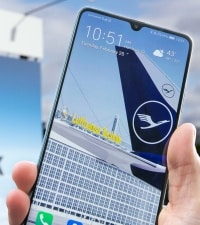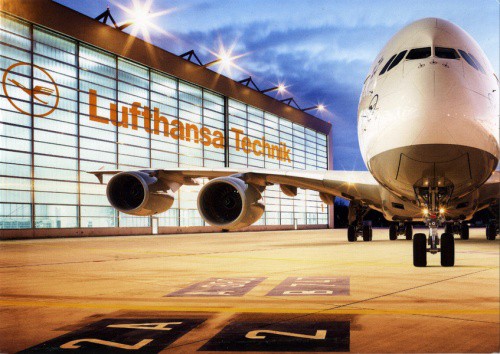Technical aircraft maintenance service provider Lufthansa Technik has set up two separate industrial grade 5G private wireless networks to test a couple of innovation projects at its Hamburg base.
The company is thus the first outside Asia to operate a fully-fledged standalone 5G network based on the new standard (3GPP Release 16) in an industrial environment. This enables higher security and a completely free configuration, which allows the company's own 5G networks to be adapted exactly to the requirements of the respective evaluation projects, for example in the ratio of upload and download bandwidth.
The two innovation projects on trial are in the field of VIP completion and engine overhaul respectively. Lufthansa Technik set up the two private 5G networks with different technology and network providers.
"Continuous innovation is part of our corporate DNA, and this is what drives us to constantly try out new approaches," explained Soeren Stark, member of Lufthansa Technik's executive board, responsible for Technical Operations, Logistics and IT. "The first two application cases already impressively demonstrate the valuable contribution 5G technology can make to the aviation industry. It will also pave the way for numerous new innovations at Lufthansa Technik that will benefit our company, our employees and also our customers".
Instead of extending publicly available mobile networks to the Lufthansa base, a completely independent infrastructure has been installed, with its own antennas and servers that can only be accessed by Lufthansa Technik. Therefore, "LH-Technik" appears as the network operator in the display of the mobile devices used.
Virtual Table Inspection
Currently, Lufthansa Technik’s aviation customers travel to Hamburg to carry out components inspections when engines are overhauled, which means that they are entirely disassembled and inspected in utmost detail.
 With its proof-of-concept (PoC) project called “Virtual Table Inspection”, Lufthansa Technik will trial inspections of individual engine parts collaboratively over a fast, high-definition video link. The company’s aviation customers can remotely attend the inspection of engine parts and no longer have to travel to Hamburg for it.
With its proof-of-concept (PoC) project called “Virtual Table Inspection”, Lufthansa Technik will trial inspections of individual engine parts collaboratively over a fast, high-definition video link. The company’s aviation customers can remotely attend the inspection of engine parts and no longer have to travel to Hamburg for it.
They will be guided directly through the engine shop by means of a mobile device. Via a video stream they can communicate in real time with the engine mechanics performing the work, inspect the dismantled parts in high-resolution on the screen and make the appropriate order decisions.
For this purpose, Nokia has been tapped to set up the 5G private wireless network that will remove the need for customers to physically attend servicing by providing seamless video access to the engine overhaul shop floor.
Nokia is its Nokia Digital Automation Cloud (DAC) solution, a plug-and-play digital automation platform that can easily scale from a small local deployment to multiple sites of large systems - all managed from the same web portal.
Its flexibility will enable Lufthansa Technik to configure and adapt the network to precisely meet the project’s needs. Remote, high-resolution screen inspection calls for high-bandwidth and low-latency capability to accommodate demanding upload and download speeds as well as adequate computing power to handle the processing requirements of live transmission.
Kathrin Buvac, president of Nokia Enterprise, said: "This application captures the essential value of fast, secure 5G private wireless networking to help improve operational efficiency, productivity and service. It highlights the potential for new ways of working that benefit not only our customers, but also the markets they serve."
Lufthansa Technik expressed positive feedback on the ease of deployment for the trial of the Virtual Table Inspection project.
“In early phases, the private wireless network has shown to be technically first rate as well as being flexible to deploy and easy to tailor to our applications and work environment,” said Dr. Claudius Noack, project lead, Lufthansa Industry Solutions said.
Maik Voigt, project lead at Lufthansa Technik echoed the sentiment. “Not only does the Nokia solution help to transform how we work with our customers, but it’s also a great fit for our industry’s needs,” he said.
AR to visualise 3D design data
 The second PoC project uses augmented reality to virtually visualise the 3D design data of the planned cabin interior in empty aircraft fuselages on tablets and other devices. By means of live data transmission, the technicians on site always have the opportunity to check the current position of all planned components and, additionally, to coordinate any necessary changes with the developers through collaborative video functions.
The second PoC project uses augmented reality to virtually visualise the 3D design data of the planned cabin interior in empty aircraft fuselages on tablets and other devices. By means of live data transmission, the technicians on site always have the opportunity to check the current position of all planned components and, additionally, to coordinate any necessary changes with the developers through collaborative video functions.
In addition, they can work with the component developers in the factories using collaborative video. This was not possible before launching the campus network, as the transfer of the extensive CAD data required high bandwidths, even inside the parked aircraft.
Lufthansa Technik has chosen Vodafone Business to build a standalone private 5G campus network at the 8,500 square meters Lufthansa base at Hamburg Airport
“From factories, to ports and even airplane hangars, private 5G networks are flexible, scalable and can be tailored to their requirements, helping them achieve what they need. We believe the businesses that invest in new technologies today will be at the forefront tomorrow,” said Vinod Kumar, CEO, Vodafone Business.
Up to four very large aircrafts can park in the connected Lufthansa base at the same time, requiring very high bandwidth to manage the demand. With a capacity of more than one gigabit per second and latency times of less than ten milliseconds, Vodafone Business said the private 5G Stand Alone Standard (5G SA) network is the perfect solution.
And since the private network is completely independent from the public one, from the server and the core, to the antenna. The data also never leaves the Lufthansa base; it is processed directly on site using multi-access edge computing (MEC) that allows real-time data flow.
5G is a game changer
Both projects have a very high demand for bandwidth for wireless data transmission, which could not be covered adequately by the previous 4G and Wi-Fi technologies. The public 4G upload rate was often no longer sufficient for high-resolution video streams, and the Wi-Fi standard, as an alternative, is not designed for a change of location between individual cells, which previously often led to connection terminations.
5G technology solves both problems at once, as it not only enables a significantly higher data transmission rate (in the final expansion stage up to 10 Gbit/s compared to a maximum of 1Gbit/s for 4G/LTE), but also allows mobile devices to switch smoothly between individual radio cells.
One such network will cover one of the two engine shops in Hamburg, another a complete aircraft hangar with a surface area of about 8,500 square meters. In the latter case, it is particularly important that sufficient signal strength is always available inside the parked aircraft to ensure a secure connection. In order to ensure this at all times, 5G technology allows so-called beamforming, in which the antenna focuses its transmission field, which is otherwise spread across the entire hangar, on one or more mobile devices located in the hangar.
With frequencies that are close to those of conventional Wi-Fi (3.7 – 3.8 GHz), the radiation level remains within the non-critical range at all times, even in the focused use of 5G technology, so that any risk to employees in the relevant areas is ruled out. The German Federal Network Agency has approved Lufthansa Technik's use of the company's own frequencies accordingly.
If 5G proves successful with the users in the two PoC projects, the technology will be rolled out to other Lufthansa Technik divisions in the near future so that its advantages can also be used in daily aircraft maintenance operations.



